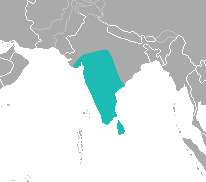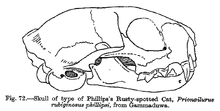Rusty-spotted cat
| Rusty-spotted cat | |
|---|---|
| | |
| Scientific classification | |
| Kingdom: | Animalia |
| Phylum: | Chordata |
| Class: | Mammalia |
| Order: | Carnivora |
| Family: | Felidae |
| Genus: | Prionailurus |
| Species: | P. rubiginosus |
| Binomial name | |
| Prionailurus rubiginosus[2] Geoffroy Saint-Hilaire, 1831 | |
 | |
| Rusty-spotted cat range | |
The rusty-spotted cat (Prionailurus rubiginosus) is one of the cat family's smallest members, of which historical records are known only from India and Sri Lanka.[3] More recently, it was also recorded in the western Terai of Nepal. Since 2016, the global wild population is listed as Near Threatened on the IUCN Red List as it is fragmented and affected by loss and destruction of prime habitat, deciduous forests.[1]
Characteristics
The rusty-spotted cat is the smallest wild cat in Asia and rivals the black-footed cat as the world's smallest wild cat. It is 35 to 48 cm (14 to 19 in) in length, with a 15 to 30 cm (5.9 to 11.8 in) tail, and weighs only 0.9 to 1.6 kg (2.0 to 3.5 lb). The short fur is grey over most of the body, with rusty spots over the back and flanks, while the underbelly is white with large dark spots. The darker colored tail is thick and about half the length of the body, and the spots are less distinct. There are six dark streaks on each side of the head, extending over the cheeks and forehead.[4]
Distribution and habitat

Rusty-spotted cats have a relatively restricted distribution. They mainly occur in moist and dry deciduous forests as well as scrub and grassland, but are likely absent from evergreen forest.[5] They prefer dense vegetation and rocky areas.[6][7]
Distribution of subspecies
Two subspecies are recognized:[2]
- Prionailurus rubiginosus rubiginosus — lives in India
- Prionailurus rubiginosus phillipsi — lives in Sri Lanka
In India, they were long thought to be confined to the south, but records have established that they are found over much of the country.[5] They were observed in the Gir Wildlife Sanctuary and National Park, in the Tadoba-Andhari Tiger Reserve in Maharashtra, on India's east coast, and in eastern Gujarat.[7][8][9][10] Camera trapping revealed their presence in the Pilibhit Tiger Reserve in the Indian Terai and in the Nagzira Wildlife Sanctuary in Maharashtra.[11][12] In western Maharashtra, there is a breeding population of rusty-spotted cats in a human dominated agricultural landscape, where rodent densities are high.[13] In December 2014 and in April 2015, the species was photographed by camera traps in Kalesar National Park, Haryana.[14]
In March 2012, a rusty-spotted cat was photographed for the first time in Bardia National Park, and in March 2016 also in Suklaphanta Wildlife Reserve, both in Nepal.[15]
In Sri Lanka, there are a few records from montane and lowland rainforest. There are two distinct populations, one in the dry zone and the other in the wet zone.[16]
Ecology and behaviour
Very little is known about ecology and behaviour of rusty-spotted cats in the wild. Captive ones are mostly nocturnal but also briefly active during the day.[4] Most wild ones were also recorded after dark. Several individuals were observed hiding in trees and in caves.[17][18][19]
They feed mainly on rodents and birds, but may also hunt lizards, frogs, and insects. They hunt primarily on the ground, making rapid, darting movements to catch their prey. They apparently venture into trees to escape larger predators. Captive females and males both scent-mark their home range by spraying urine.[4]
Reproduction
Oestrus lasts five days, and mating is unusually brief. Since the female is likely to be vulnerable during this period, its brevity may be an adaptation to help it avoid larger predators. The female prepares a den in a secluded location, and gives birth to one or two kittens after a gestation of 65–70 days. At birth, the kittens weigh just 60 to 77 g (2.1 to 2.7 oz), and are marked with rows of black spots. They reach sexual maturity at around 68 weeks, by which time they have developed the distinctive adult coat pattern of rusty blotches. Rusty-spotted cats have lived for twelve years in captivity, but their lifespan in the wild is unknown.[4]
Threats
Habitat loss and the spread of cultivation are serious problems for wildlife in both India and Sri Lanka. Although there are several records of rusty-spotted cats from cultivated and settled areas, it is not known to what degree cat populations are able to persist in such areas. There have been occasional reports of rusty-spotted cat skins in trade.[5] In some areas, they are hunted for food or as livestock pests.[4]
Conservation
The Indian population is listed on CITES Appendix I. The Sri Lankan population is included on CITES Appendix II. The species is fully protected over most of its range, with hunting and trade banned in India and Sri Lanka.[1]
In captivity
As of 2010, the captive population of P. r. phillipsi comprised 56 individuals in eight institutions, of which 11 individuals were kept in the Colombo Zoo and 45 individuals in seven European zoos.[20]
Local names
In Sri Lanka, the rusty-spotted cat is known as Handun Diviya or Kola Diviya.[5]
The terms 'Handun Diviya' and 'Kola Diviya' are also used by the local community to refer to the fishing cat. Both animals are nocturnal and elusive, and therefore it is difficult to determine which cat is specifically referred to as 'Handun Diviya'.
References
- 1 2 3 Mukherjee, S.; Duckworth, J. W.; Silva, A.; Appel, A. & Kittle, A. (2016). "Prionailurus rubiginosus". IUCN Red List of Threatened Species. Version 2016.2. International Union for Conservation of Nature.
- 1 2 Wozencraft, W.C. (2005). "Order Carnivora". In Wilson, D.E.; Reeder, D.M. Mammal Species of the World: A Taxonomic and Geographic Reference (3rd ed.). Johns Hopkins University Press. pp. 543–544. ISBN 978-0-8018-8221-0. OCLC 62265494.
- 1 2 Pocock, R.I. (1939). The Fauna of British India, including Ceylon and Burma. Mammalia. – Volume 1. London: Taylor and Francis Ltd. Pages 276–280.
- 1 2 3 4 5 Sunquist, M.; Sunquist, F. (2002). Wild cats of the World. Chicago: University of Chicago Press. pp. 237–240. ISBN 0-226-77999-8.
- 1 2 3 4 Nowell, K., Jackson, P. (1996). Rusty-spotted Cat Prionailurus rubiginosus In: Wild Cats: status survey and conservation action plan. IUCN/SSC Cat Specialist Group, Gland, Switzerland
- ↑ Kittle, A., Watson, A. (2004). Rusty-spotted cat in Sri Lanka: observations of an arid zone population. Cat News 40: 17–19
- 1 2 Patel, K. (2006). Observations of rusty-spotted cat in eastern Gujarat. Cat News 45: 27–28
- ↑ Pathak, B. J. (1990). Rusty spotted cat Felis rubiginosa Geoffroy: A new record for Gir Wildlife Sanctuary and National Park. Journal of the Bombay Natural History Society 87: 8
- ↑ Dubey, Y. (1999). Sighting of rusty spotted cat in Tadoba Andhari Tiger Reserve, Maharashtra. Journal of the Bombay Natural History Society 96 (2): 310
- ↑ Manakadan, R. and Sivakumar, S. (2006). Rusty-spotted cat on India's east coast. Cat News 45: 26
- ↑ Anwar, M., Kumar, H., Vattakavan, J. (2010). Range extension of rusty-spotted cat to the Indian Terai. Cat News 53: 25–26.
- ↑ Patel, K. (2010). New distribution record data for rusty-spotted cat from Central India. Cat News 53: 26–27.
- ↑ Athreya, V. (2010). Rusty-spotted cat more common than we think? Cat News 53: 27.
- ↑ Ghaskadbi, P., Habib, B., Mir, Z., Ray, R., Talukdar, G., Lyngdoh, S., Pandav, B., Nigam, P. and Kaur, A. (2016). Rusty-spotted Cat in Kalesar National Park and Sanctuary, Haryana, India. Cat News 63: 28–29.
- ↑ Appel, A. 2016. The first records of Rusty-spotted Cat in Nepal. Small Wild Cat Conservation News 2: 8–10.
- ↑ Deraniyagala, P. E. P. (1956). A new subspecies of rusty spotted cat from Ceylon. Spolia Zeylanica 28: 113.
- ↑ Patel, K. (2011). Preliminary survey of small cats in Eastern Gujarat, India. Cat News 54: 8–11.
- ↑ Anwar, M., Hasan, D., Vattakavan, J. (2012). Rusty-spotted cat in Katerniaghat Wildlife Sanctuary, Uttar Pradesh State, India. Cat News 56: 12–13.
- ↑ Vasava, A., Bipin, C. M., Solanki, R., and Singh, A. (2012). Record of rusty-spotted cat from Kuno Wildlife Sanctuary, Madhya Pradesh, India. Cat News 57: 22–23.
- ↑ Bender, U. (2011). International Register and Studbook for the Rusty-Spotted Cat Prionailurus rubiginosus phillipsi (Pocock, 1939). Frankfurt Zoo, Frankfurt.
External links
| Wikispecies has information related to: Prionailurus rubiginosus |
| Wikimedia Commons has media related to Prionailurus rubiginosus. |
- IUCN Cat Specialist Group: Rusty-spotted Cat Prionailurus rubiginosus
- ARKive: Rusty-spotted cat (Prionailurus rubiginosus)
- DNA India : In a first, rusty-spotted cat sighted in Kutch. April 2013

